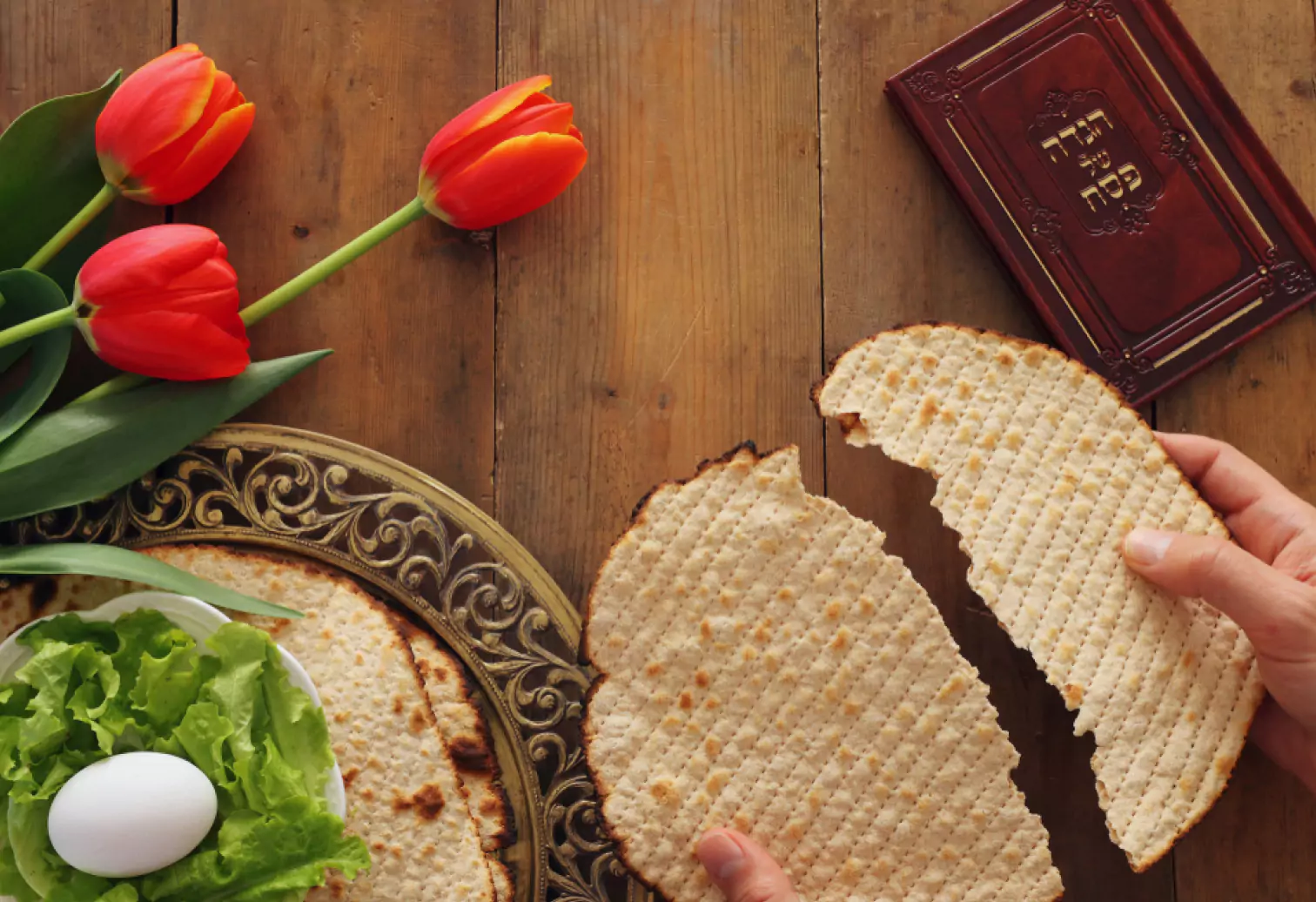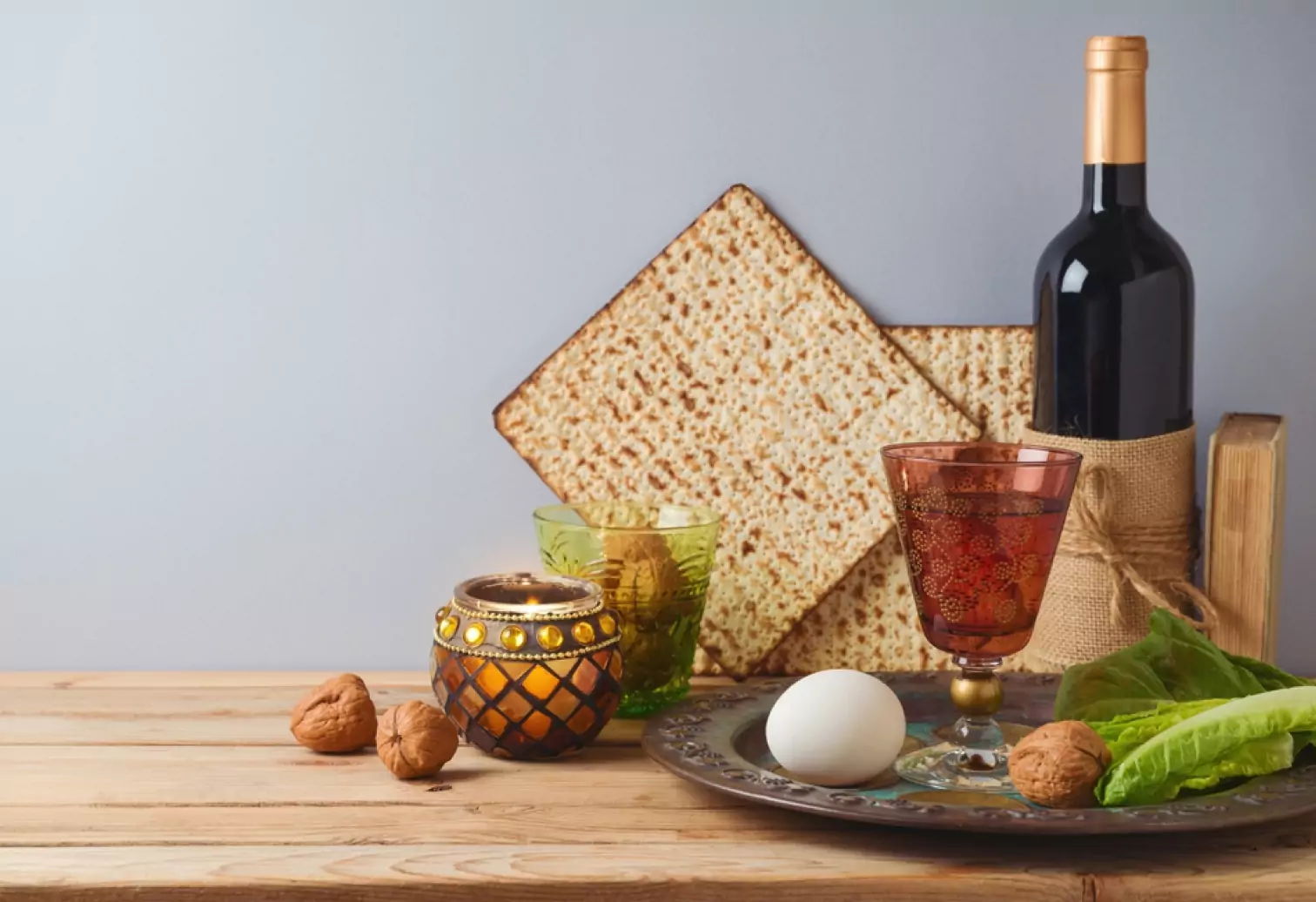Celebrating Passover: Traditional Foods and Tips for a Healthy Holiday

Key Takeways
April brings in a new season and a host of holidays, one of which is Passover, or Pesach in Hebrew—a widely celebrated Jewish holiday. It commemorates the Israelites' liberation from slavery in Egypt and their journey to freedom.
The holiday, celebrated for eight days and nights, is typically observed in April or May and begins on April 15 this year. During Passover, Jewish people eat symbolic foods like matzo and charoset and tell the story of the Hebrews' liberation from bondage.
The History of Passover
In addition to its culinary traditions, Passover also has a rich religious history. As one of the oldest and perhaps most important holidays, Passover is a time for family and friends to come together and celebrate their heritage. But what's the story behind it? How did it start, and why does it continue to be such an important holiday for Jewish people worldwide?
The Biblical story of Passover begins over 3,500 years ago in Egypt, where the Israelites were enslaved at the time. As the story goes, God spoke to Moses, telling him to lead his people out of slavery to freedom. Moses went to Pharaoh and asked him to let the Israelites go, but the Pharaoh refused. So, God sent ten plagues down on the Egyptians as punishment, and Moses led his people to freedom as promised.
The word Passover itself refers to the tenth plague that God sent to the Egyptians where the firstborn son of each family was killed. Moses' people were told to sacrifice a lamb and paint the doorposts with the blood so the angel of death would "Pass over" that dwelling and spare the sons of the Israelites. The foods, table arrangement, and readings done during the Passover Seder are all instructive and full of meaning.
Interestingly, Orthodox Jewish people write G-d instead of God because they consider the written word to be sacred. In Hebrew, the name of God is transliterated as YHWH or JHVH which forms a biblical proper name for God. These four letters are considered too holy to be written down, so Orthodox Jewish people use the word "G-d" instead. This practice reminds Jewish people about the importance of using God's name with reverence and respect and prevents people from taking God's name in vain. In addition, by writing "G-d," Orthodox Jewish people can avoid pronouncing the Tetragrammaton aloud.
How is Passover Celebrated?
Passover is celebrated for eight days, beginning on the 15th day of Nissan in the Hebrew calendar. During Passover, Jewish people eat celebratory foods, tell stories, and perform traditional ceremonies.
The highlight of this time is the Passover Seder meal where family and friends come together to celebrate, remember their history, and teach their children about it. The Seder plate is the centerpiece of the meal, and it is usually adorned with various symbolic foods. A seder plate is a special plate used during the Passover Seder, decorated with six foods that have symbolic meaning.
The foods on the plate represent different aspects of the story of the Exodus from Egypt. For example, the roasted egg symbolizes spring and new life. The bitter herbs represent the bitter experience of slavery. The lamb bone represents the sacrifice made to save the Israelites from bondage.
Together, these foods help to tell the story of Passover and to remind us of the importance of freedom.
Some Traditional Passover Foods we Love

Many people think of Passover as a time for eating matzah and avoiding leavened bread. But there's so much more to the holiday than that! When it comes to Passover, certain traditional foods are a must. From matzo ball soup to gefilte fish, these main dishes have been passed down for generations. They are an essential part of the holiday.
The beginning of Passover means a lot of cooking for many, but if you’re not familiar with Passover foods, you may feel lost. From sweet to savory, traditional Passover foods are as varied as they are flavorful.
Here are some of the most common traditional Passover foods we recommended adding to your meal, along with the nutritional content of each one:
Matzoh Bread

Matzoh is a type of unleavened bread made from flour and water. It has a cracker-like texture and is usually very thin. Jewish people have been eating matzoh for thousands of years; it’s part of many Jewish traditions and religious ceremonies. According to the Torah, God told Israelites to eat only unleavened bread during the seven days of Passover to remind them that their people left captivity in haste and didn't have time for the bread to rise.
Nutritional Content: 1 Matzoh has 120 calories, 0.5 grams of fat, 26 grams of carbohydrates, and 4 grams of protein
Maror
These are bitter herbs eaten during the Passover meal. They serve as a reminder of the bitterness of slavery and are dipped in charoset, which symbolizes the mortar used by the Hebrews when the Egyptians enslaved them. The herbs used for Maror may vary by geography and availability, but bitter lettuces and horseradishes are the most common.
Nutritional Content: 1 tablespoon of Maror with horseradish has 7 calories, 0 grams of fat, 2 grams of carbohydrate, and 0 grams of protein
Karpas
Karpas is a traditional dish eaten during the Passover Seder. It's made from either fresh vegetables or dried fruits and can be enjoyed as a side dish or appetizer.
Nutritional Content: This will vary depending on whether it's made from vegetables or dried fruit
Root Vegetables
Grain-free for Passover this year? You can keep with tradition by adding more of the veggies to your meal! Roasted root veggies like parsnips and sweet potato are often found as grain-free, healthy Passover sides.
Nutritional Content: 1 cup of roasted root vegetables contains approximately 55 calories, 1 grams of fat, 15 grams of carbohydrates, and 1 gram of protein
Zucchini
Zucchini is another typical side dish and a great way to curate a healthy Passover table. Vegetable sides can be cooked in olive oil or lemon juice and are great paleo and keto options for your Passover feast.
Nutritional Content: 1 cup of zucchini has 21 calories, 0.5 grams of fat, 4 grams of carbohydrates, and 2 grams of protein
Seder Wine

The word "seder" refers to the list of foods used to tell the story of Moses leading the Israelis out of Egypt. The wine is quite a common addition to Passover meals. This wine is usually red, symbolizing the blood that was shed when the Israelis were freed. It is symbolic to drink four glasses of wine.
Seder wines can be sweet or dry, but they must be kosher for Passover. In addition, many Jewish people believe that it is good luck to only use newly-pressed wine for the holiday. Partaking in the seder meal and drinking seder wine is a way to commemorate and celebrate this historic event.
Nutritional Content: 5 fluid ounces of Seder wine contains 125 calories, 0 grams of fat, 4 grams of carbohydrates, and 0 grams of protein. The calorie and carbohydrate content will depend on whether this is a sweet wine or dry wine, with a sweet wine typically having more calories and carbohydrates.
Coconut Macaroons
Coconut macaroons are cookies made primarily from shredded coconut and are one of the most common sweet treats found on Passover tables. They are often made with almond flour, making them a great gluten-free and dairy-free Passover dessert.
Nutritional Content: 1 medium 2 inch diameter macaroon has roughly 100 calories, 1 gram of fat, 17 grams of carbohydrates, and 1 gram of protein
Kugel
Kugel is a baked pudding or casserole made from lokshen or Jewish egg noodles or potatoes. Lokshen (more on that below) is the Yiddish word for noodle. Jewish egg noodles are made from flour, eggs, water, and salt. They are wide and flat and have a slightly chewy texture. Potatoes are also a common ingredient in kugel, and they can be either sweet or savory.
Sweet potato kugel is typically made with egg noodles, while savory kugel is made with potatoes. The type of noodle or potato you use in your kugel will depend on your preference. Some people prefer the rich flavor of egg noodles, while others find that potatoes add a more substantial texture to the dish.
Nutritional Content: 3 ounces of Potato Kugel contains 100 calories, 3 grams of fat, 13 grams of carbohydrates, and 4 grams of protein
Brisket

Brisket is a cut of beef that is usually slow-cooked, smoked, or braised, and it is one of the most commonly found Passover recipes. Some of the more common spices used in brisket recipes for Passover include kosher salt, paprika, ground black pepper, and garlic powder.
Nutritional Content: 3 ounces of lean beef brisket contains 167 calories, 5 grams of fat, 0 grams of carbohydrates, and 28 grams of protein
Roast Chicken
Roast chicken is another protein commonly found on Passover tables. There’s a lot of room to experiment here. You can play around with stuffings, braise it, add it to your slow-cooker, or keep it classic!
Nutritional Content: 3 ounces of roast chicken (no skin) contains 144 calories, 4 grams of fat, 0 grams of carbohydrates, and 28 grams of protein
Borscht
Borscht is a soup made with beets and potatoes. This hearty soup is served with sour cream or yogurt and garnished with dill or parsley. Jewish borscht is a traditional dish that originates in Eastern Europe and is now a popular Passover dish in other parts of the world.
Nutritional Content: 6 ounces of Borscht contains 50 calories, 0 grams of fat, 13 grams of carbohydrates, and 1 gram of protein. This does not include sour cream or yogurt
Egg Lokshen

Egg lokshen is a noodle made from eggs and flour, and it's often used in Jewish cooking. Egg lokshen is traditional in Ashkenazi cuisine and is often used in soups and casseroles. It's similar to Italian pasta or Chinese noodles, but it has a unique, slightly chewy texture and rich flavor.
Nutritional Content: 1.25 cups of Egg Lokshen contains 230 calories, 2 grams of fat, 43 grams of carbohydrates, and 9 grams of protein
Roasted Lamb
Tired of brisket and chicken? Try some lamb! A Passover delicacy, the lamb, is typically roasted with herbs like fennel and olive oil. Some sources suggest that in ancient times, Passover included the sacrifice of a paschal lamb, eaten at Seder on the first night of the holiday. This changed after the Temple in Jerusalem was destroyed in the first century.
Nutritional Content: 3 ounces of roasted lamb contains 153 calories, 6 grams of fat, 0 grams of carbohydrates, and 24 grams of protein
Schmaltz
Schmaltz, a Yiddish word that means "fat," is rendered in English either as schmaltz or chicken fat. It's a type of poultry fat rendered from the fatty tissues of the bird (usually chicken or goose) and has a high smoke point. Schmaltz is often used to flavor foods such as roasted potatoes, onions, and chicken.
Nutritional Content: 1 tablespoon of Schmaltz contains 115 calories, 13 grams of fat, 0 grams of carbohydrates, and 0 grams of protein
Charoset
Charoset is a paste made from chopped nuts, grated apples, cinnamon, and sweet red wine. Charoset is representative of the mortar and brick made by the Jews when they slaved for the Pharaoh. This is used as a type of relish into which the maror, the bitter herb, is dipped and then shaken off before eating.
Nutritional Content: This will depend on how it is made, but 1 tablespoon of Charoset typically contains about 30 calories, 2 grams of fat, 3 grams of carbohydrates, and 0.5 grams of protein
Gribenes
Gribenes is made from crispy onions and chicken skins. It is traditionally served as an appetizer or as a side dish. Gribenes is high in fat and calories, but it is also packed with crunchy texture and flavor.
Nutritional Content: This will depend on the ratio of chicken skins to onion, but 3 ounces of chicken skins contains 343 calories, 33 grams of fat, 1 gram of carbohydrates, and 10 grams of protein
Matzah Ball Soup

Matzah ball soup (also known as Matzah, matzoh, or matza ball soup) is a popular Jewish dish during the Passover holiday. The soup consists of broth, matzah balls, and various vegetables. Matzah ball soup is considered comfort food and is often served as a main course. Matzah balls are much like dumplings, but they are made from matzo meal instead of flour. This is because Passover meals cannot include any grains that might ferment and become leavened.
Nutritional Content: This will depend on the size of matzah balls and vegetables used in the soup but 1 cup of soup will have roughly 150 calories, 7 grams of fat, 13 grams of carbohydrates, and 7 grams of protein
Dark Chocolate
Passover desserts are a vital part of the holiday (yum!). You may find brownies with chocolate chips, fudgy chocolate cake, and other sweet treats on Passover tables. On Passover, there are many dessert recipes to choose from. If you want to make your desserts a little bit healthier this year, try using dark chocolate, which is rich in antioxidants.
Nutritional Content: 1 ounce of 70 to 80 percent dark chocolate contains 170 calories, 12 grams of fat, 13 grams of carbohydrates, and 2 grams of protein
Dietitian-Approved Tips for a Healthy Passover

Passover is a time for family and tradition, but it can also be a time of temptation. And, with all those delicious foods, who can blame you? But there are some easy ways to enjoy the celebrations while still ensuring you have a healthy Passover.
From eating the right foods to getting enough exercise through the holiday, a little planning can go a long way toward keeping you feeling your best. This year, try to focus on your health and tradition during Passover. Here are some tips from the Nutrisense team to help you stay on track:
- Eat the proteins and fiber on your plate first. It will help your body slow its uptake of sugars from carbs and sugar-laden foods.
- Try substituting a nut butter for the sweet red wine in your charoset this year. You’ll be substituting sugars for some extra protein and healthy fat while still maintaining a desert profile.
- Make carbohydrate-heavy foods the smaller portions on your plate.
- Start with small portions. You can always go back for more, but remember that it takes your body approximately 20 minutes to register if it is full.
- Watch your portion sizes. It's easy to overeat during Passover meals, so be mindful of how much you're eating.
- Make sure you're drinking plenty of water. It will help keep you hydrated and prevent overeating.
- Go for a short walk after your meal. This will help your blood glucose levels remain steady and aid your digestion.
Find the right Nutrisense programto turn insight into progress.
Go Beyond Glucose Data with Nutrisense
Your glucose can significantly impact how your body feels and functions. That’s why stable levels are an important factor in supporting overall wellbeing. But viewing glucose isn't enough. Nutrisense, you’ll be able to learn how to use your body's data to make informed lifestyle choices that support healthy living.
One-to-one coaching
Sign up to access insurance-covered video calls to work with a glucose expert: a personal registered dietitian or certified nutritionist who will help tailor your lifestyle and diet to your goals.
Monitor and measure what matters
With the Nutrisense CGM Program, you can monitor your glucose with health tech like glucose biosensors and continuous glucose monitor (CGM)s, and analyze the trends over time with the Nutrisense App. This will help you make the most informed choices about the foods you consume and their impact on your health.
Find your best fit
Ready to take the first step? Start with our quiz to find the right Nutrisense program to help you take control.

Amanda is a Nutrition Manager and Registered Dietitian, with a Masters in Dietetics from Stephen F. Austin State University. Originally from south GA, she got her undergrad degree from Texas Tech University. She worked at a hospital in Fort Worth, TX, for 4 years as a dietitian, counseling those living with HIV.




.jpeg)